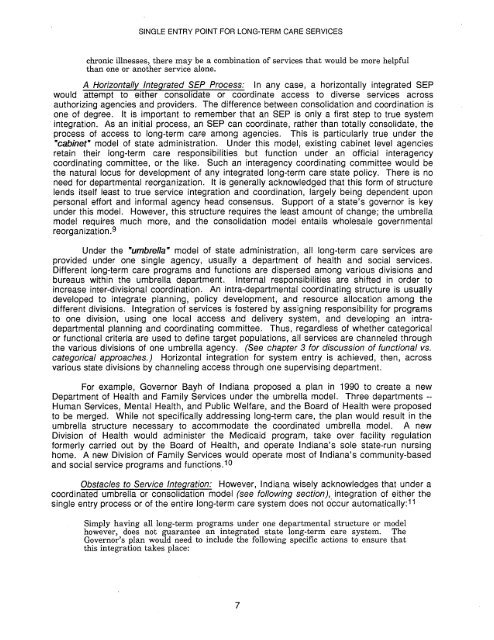long-term care - Legislative Reference Bureau
long-term care - Legislative Reference Bureau
long-term care - Legislative Reference Bureau
You also want an ePaper? Increase the reach of your titles
YUMPU automatically turns print PDFs into web optimized ePapers that Google loves.
SINGLE ENTRY POINT FOR LONG-TERM CARE SERVICES<br />
chronic illnesses, there may be a combination of services that would be more helpful<br />
than one or another service alone.<br />
A Horizontally Integrated SEP Process: In any case, a horizontally integrated SEP<br />
would attempt to either consolidate or coordinate access to diverse services across<br />
authorizing agencies and providers. The difference between consolidation and coordination is<br />
one of degree. It is important to remember that an SEP is only a first step to true system<br />
integration. As an initial process, an SEP can coordinate, rather than totally consolidate, the<br />
process of access to <strong>long</strong>-<strong>term</strong> <strong>care</strong> among agencies. This is particularly true under the<br />
"cabinet" model of state administration. Under this model, existing cabinet level agencies<br />
retain their <strong>long</strong>-<strong>term</strong> <strong>care</strong> responsibilities but function under an official interagency<br />
coordinating committee, or the like. Such an interagency coordinating committee would be<br />
the natural locus for development of any integrated <strong>long</strong>-<strong>term</strong> <strong>care</strong> state policy. There is no<br />
need for departmental reorganization. It is generally acknowledged that this form of structure<br />
lends itself least to true service integration and coordination, largely being dependent upon<br />
personal effort and informal agency head consensus. Support of a state's governor is key<br />
under this model. However, this structure requires the least amount of change; the umbrella<br />
model requires much more, and the consolidation model entails wholesale governmental<br />
reorganization. 9<br />
Under the "umbrella" model of state administration, all <strong>long</strong>-<strong>term</strong> <strong>care</strong> services are<br />
provided under one single agency, usually a department of health and social services.<br />
Different <strong>long</strong>-<strong>term</strong> <strong>care</strong> programs and functions are dispersed among various divisions and<br />
bureaus within the umbrella department. Internal responsibilities are shifted in order to<br />
increase inter-divisional coordination. An intra-departmental coordinating structure is usually<br />
developed to integrate planning, policy development, and resource allocation among the<br />
different divisions. Integration of services is fostered by assigning responsibility for programs<br />
to one division, using one local access and delivery system, and developing an intradepartmental<br />
planning and coordinating committee. Thus, regardless of whether categorical<br />
or functional criteria are used to define target populations, all services are channeled through<br />
the various divisions of one umbrella agency. (See chapter 3 for discussion of functional vs.<br />
categorical approaches.) Horizontal integration for system entry is achieved, then, across<br />
various state divisions by channeling access through one supervising department.<br />
For example, Governor Bayh of Indiana proposed a plan in 1990 to create a new<br />
Department of Health and Family Services under the umbrella model. Three departments -<br />
Human Services, Mental Health, and Public Welfare, and the Board of Health were proposed<br />
to be merged. While not specifically addressing <strong>long</strong>-<strong>term</strong> <strong>care</strong>, the plan would result in the<br />
umbrella structure necessary to accommodate the coordinated umbrella model. A new<br />
Division of Health would administer the Medicaid program, take over facility regulation<br />
formerly carried out by the Board of Health, and operate Indiana's sole state-run nursing<br />
home. A new Division of Family Services would operate most of Indiana's community-based<br />
and social service programs and functions. 10<br />
Obstacles to Service Integration: However, Indiana wisely acknowledges that under a<br />
coordinated umbrella or consolidation model (see following section), integration of either the<br />
single entry process or of the entire <strong>long</strong>-<strong>term</strong> <strong>care</strong> system does not occur automatically: 11<br />
Simply having all <strong>long</strong>-<strong>term</strong> programs under one departmental structure or model<br />
however, does not guarantee an integrated state <strong>long</strong>-<strong>term</strong> <strong>care</strong> system. The<br />
Governor's plan would need to include the following specific actions to ensure that<br />
this integration takes place:<br />
7
















